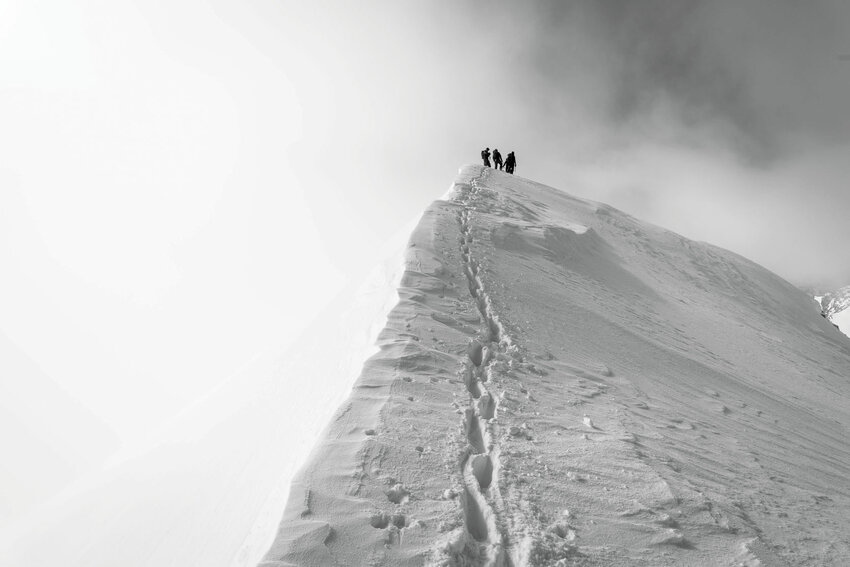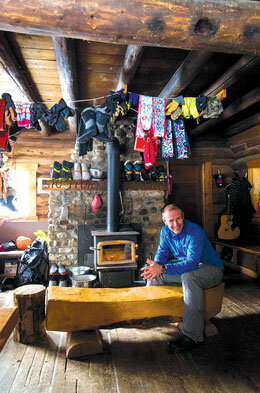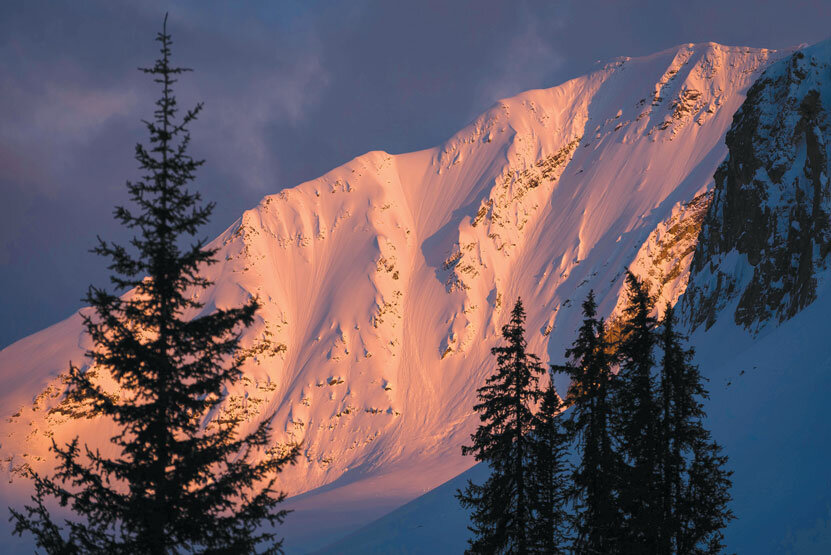 On the summit of the President, in B.C.’s President Range in Yoho National Park.[/caption]
On the summit of the President, in B.C.’s President Range in Yoho National Park.[/caption] Our group was in high spirits as we skinned up the Little Yoho Valley last April. The weather forecast was perfect. A warm storm had settled out deep weaknesses in a typically complicated Canadian Rockies snowpack. The avalanche bulletin’s regular updates had transitioned to a boilerplate spring message. This was somewhat of a relief to our group. While we all had been through some avalanche education and kept up on the forecasts and snowpack discussions published throughout the season, we were not “experts” in assessing avalanche risk, and the Canadian Rockies are known as a tricky range to predict danger.
 Inside the Stanley Mitchell Hut.
Inside the Stanley Mitchell Hut.We were destined for the Stanley Mitchell Hut, one of the oldest in the Canadian Rockies (built 1939). It is recognized as a federal heritage building, and considered the gem of the Alpine Club of Canada’s hut system. Groups skiing out past us reported excellent and stable powder on north aspects – we couldn’t wait to ski the many glaciers and peaks surrounding the hut.
Our first day at the hut dawned clear and, naturally, we set our sights on the highest peak in the area – the President, at 10,295 feet. We were the only party heading up that day and broke trail through boot-top powder on the scenic glacier nestled between the Vice President and President. Caching skis at the col, we booted up the steep and rocky ridge to the summit of the President and reveled in the panoramic views of the high crest of the Rockies. The trip was already a success!
 Looking toward the Vice President.
Looking toward the Vice President.We downclimbed to our skis and clicked in for the short skin over to the Vice President. As we turned a slight corner out of the col, it got icy and I stopped to put on ski crampons. Kit was breaking trail when I heard excited yelling. He had skinned onto a shallow wind slab after a hasty snow pit seemed to indicate a decent bond to the snow beneath. However, the slab failed far above Kit, dragging him towards a large cliff before he could dig into the bed surface to stop.
Chastened, we regrouped back at the col to discuss. Had the slide been any bigger, it could have carried Kit over the edge to injury or worse. Reflecting on the close call we turned our back on the Vice President and skied excellent powder back to the hut.
On day three, we opted to change aspect and ski more south-facing slopes off the summit of Mt. McArthur. Despite the change, we triggered a section of the summit cornice just by walking on the rocks nearby. Then, gingerly working our way down one at a time, we ski cut a short convex slope, triggering a hard slab that ran a short distance.
We were beginning to realize that any slope steeper than 30 degrees was suspect, but mostly where the warm storm had left crusts. This appeared to mostly be on southerly aspects, but was there anything lurking deep below that powder on the northerly slopes?
 Skiing toward Emerald Pass and Mt. Marpole.
Skiing toward Emerald Pass and Mt. Marpole.We opted to not test anything of consequence on day four, content to gawk at the views of Mt. Marpole from the mellow slopes leading to Emerald Pass. A short snow squall sent us scurrying back to the hut midday, but by staying on lower angled slopes we avoided triggering any avalanches. It was hard to say if that meant that steeper slopes higher up were stabilizing or not. However, a conversation in the hut that night with some local guides indicated that the Vice President might be a viable option for the next day. They had just come back from skiing it and reported stable snow.
The Vice President is the first peak that you see as you walk out of the hut each morning, incredibly alluring in the early light. So back up we went to try it again. The scare we had on its slopes the first day had faded and now the consensus was that we should try a slightly different line from the col, presumably where the guides had ascended the day before. Though a few inches of snow fell during the night, it didn’t seem that the level of danger would be changed significantly. No pressure, we said, we could always just ski powder on the glacier if it didn’t look good.
 The east shoulder of the Vice President from the hut at sunset.
The east shoulder of the Vice President from the hut at sunset.Arriving at the col, we knew the right hand option was out, since that’s where we triggered a slide earlier and there was still snow on the slope that hadn’t slid. That left three possible options. Option 1 was a steep, large and seemingly wind-loaded northerly slope with a bad runout. Option 2 was a couloir that looked steep and also potentially wind loaded. Option 3 was another couloir farther right that didn’t look as steep and had the shortest run out to easy slopes, but it was also potentially wind loaded. We opted to nose up into the third option and assess the snow.
We lashed skis to our packs and got in line, plugging steps up the side of the couloir. As we ascended, we periodically called observations up and down the line. We encountered a shallow wind slab and dug to isolate a column. It seemed decently bonded to the crust underneath, so we kept climbing. Higher up we began to separate a bit as we relaxed and neared the summit ridge, letting our guard down.
I took a step and watched in horror as a crack shot across the couloir and all the snow below me began sliding. “Avalanche! Avalanche! Avalanche!” I shouted in a panic as everyone below scrambled to get clear.
Austin and Gord took a couple of hurried steps out of the way but my eyes locked on Steve, a ways below them, as he quickly kicked into the snow and buried his axe. The snow battered him, breaking like a wave over the skis lashed to the outside of his pack. He hung on for a long second or two, and then … he was gone.
When the snow stopped moving, I radioed to see if Steve or Kit was on the surface (most of us had radios, which I highly recommend). I thought Kit was far enough below us and around the corner to escape the slide. I was wrong. I heard his stressed voice saying that he and Steve were carried about 300 feet and bounced through some rocks but were both on top and relatively OK. They were still assessing things but had lost gear and would appreciate help searching the debris field for it. I breathed a sigh of relief, grateful that it wasn’t a whole lot worse.
Kit and Steve were slowly digging around the debris, snow plastered to their clothes, when I arrived. The slide ripped a ski from Kit’s pack and he was missing a pole, hat, and sunglasses. Otherwise, even with the adrenaline wearing off, they seemed unhurt. We all had time to think as we methodically kicked and prodded our way downhill in a grid, searching for the gear. It was not lost on any of us that we just as easily could have had our beacons on search mode looking for a teammate. I couldn’t help but kick myself at all the warnings we had over the week and, still, here we were, with party members caught and carried in an avalanche not 100 yards from one we had triggered on the first day.
regardless of the range, it is hard to know if an avalanche-free day of backcountry skiing is a result of good decisions or just plain good luck.
We eventually found all of the gear, but still hadn’t really figured out how to talk about what had happened. We all knew that avalanches could happen in the terrain we were in, and now that they had happened multiple times on moderate terrain during relatively “safe” days, were we willing to commit to more conservative decisions in the future? Were we even aware that we were making risky decisions? Would we get another warning before something worse happened? Looking up at the summit of the Vice President and the excellent powder all around us, the beauty and fun wrapped around these temptations suggested that these were questions without easy answers.
In the coastal mountains of the Pacific Northwest, we get used to a relatively stable snowpack. Storms come in warm and wet, with the new snow typically settling out within 24-48 hours. This often leads to a deep snowpack without the persistent weaknesses preserved by cold temperatures common to inland ranges. However, regardless of the range, it is hard to know if an avalanche-free day of backcountry skiing is a result of good decisions or just plain good luck.
It’s easy to think your avalanche education and decision-making is keeping you safe, but accidents involving avalanche professionals are disturbingly common, and often fatal. Regardless, despite reading reports each season of accidents near and far, a long string of good days almost always leads to complacency. It only takes one shooting fracture, sometimes without the warnings we got, for it all to change.
Four days after we skied out from the Stanley Mitchell Hut, three of the world’s best alpinists, Jess Roskelley, 36, David Lama, 28, and Hansjörg Auer, 35, died in an avalanche on Howse Peak, about 20 miles away.